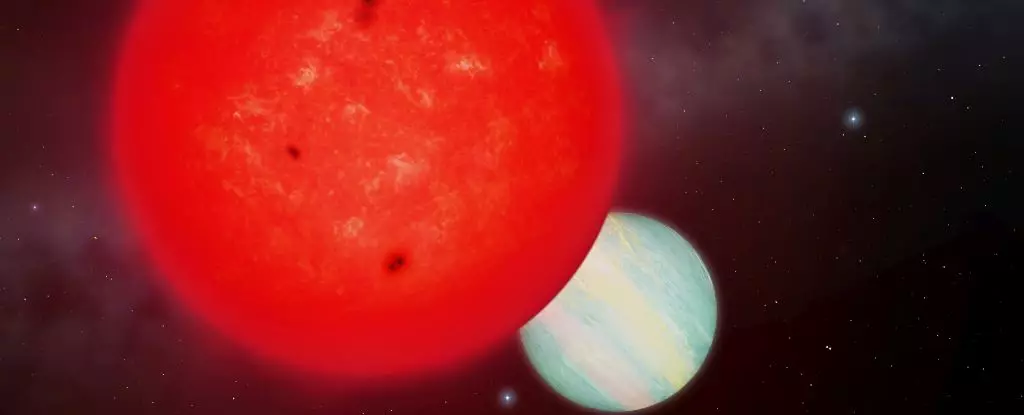In a remarkable twist of cosmic fate, astronomers have unveiled an exoplanet that challenges long-held assumptions about planet formation. Named TOI-6894b, this gas giant is not only comparable in size to Saturn, but it is also nestled around a diminutive red dwarf star significantly smaller than our Sun. Traditionally, astrophysical theories have maintained that stars of this scale lack the mass required to yield gas giants, but the discovery of TOI-6894b demands a rethink of these models. As diverse and baffling as the universe may be, this discovery brings us closer to unraveling the enigmatic process through which celestial bodies are born.
The Unlikely Parents: TOI-6894
The parent star of TOI-6894b is TOI-6894, a red dwarf measuring just 23% of the Sun’s radius and 21% of its mass. This discovery signifies that not only can planets be found orbiting red dwarfs—historically seen as limited in their planetary capacity—but that these stars can also host massive gas giants. Astrophysicist Edward Bryant, who spearheaded the research team from the University of Warwick in the UK, expressed his elation at this unexpected finding. “We did not expect planets like TOI-6894b to be able to form around stars this low-mass,” he stated, highlighting the sheer improbability of this system.
The process of star and planet formation is a dance of cosmic material where remnants from star formation create the very planets that orbit them. Yet, this relationship is presumed to be dependent on the star’s mass. Given that smaller stars have less material available in their accretion disks, forming giant planets should, in theory, be virtually impossible. The existence of TOI-6894b flips this notion on its head.
Unearthing TOI-6894b: The Search and Methodology
The groundwork for locating TOI-6894b began with meticulous analysis of data from the Transiting Exoplanet Survey Satellite (TESS), where astronomers scanned over 91,000 low-mass red dwarfs. Through the process of elimination and comparison, TOI-6894b emerged as a surefire candidate. Utilizing the European Southern Observatory’s Very Large Telescope (VLT), the team captured the tell-tale dimming of stars—as small as 17% in TOI-6894’s case—indicating the presence of an orbiting planet that dwarfs the star’s size. Such significant dips in light are rare but incredibly informative, revealing both the mass and the size of the exoplanet.
With TOI-6894b’s diameter measuring approximately 120,000 kilometers and a mass around 17% that of Jupiter, researchers deduced that this gas giant has a comparatively lighter and fluffier atmosphere. The implications of this observation signal a promising avenue for atmospheric studies that could yield insights about its chemical composition and formation history.
The Atmosphere: A Window into TOI-6894b’s Composition
The very characteristics of TOI-6894b—most notably its deep transits—make it an ideal candidate for atmospheric study. During transits, light from its star penetrates the planet’s atmosphere, allowing scientists to analyze the spectral signatures of gases present. With expectations of discovering copious amounts of methane among other constituents, astronomers have already set their sights on employing the James Webb Space Telescope (JWST) for detailed atmospheric investigations. These studies will aim to discern the fundamental building blocks of TOI-6894b’s atmosphere and potentially offer clues about its evolutionary trajectory.
According to astrophysicists like Andrés Jordán, there are two primary models regarding gas giant formation: one advocating for a gradual build-up of material, the other based on a direct collapse from disk instabilities. Given TOI-6894’s unique characteristics, the applicability of these models comes into question, making follow-up studies all the more crucial.
The Broader Implications for Planetary Science
The discovery of TOI-6894b exemplifies the need for a paradigm shift in our understanding of planetary formation dynamics. It hints that processes previously thought to be rare may, in fact, be more ubiquitous, challenging our categorizations of planetary systems. Vincent Van Eylen of University College London reiterates the profound mystery behind how such a substantial planet exists around a relatively tiny star. This discovery could open floodgates to more inquiries regarding the population of exoplanets around red dwarfs and the complex mechanisms that support their formation.
The ongoing exploration of celestial bodies in distant star systems not only enriches our comprehension of the universe but also reinforces humanity’s shared curiosity to comprehend the cosmos. Just as we push the boundaries of knowledge, the universe yields surprises that inspire future generations of scientists to delve deeper into the stellar nursery that is our cosmos.

